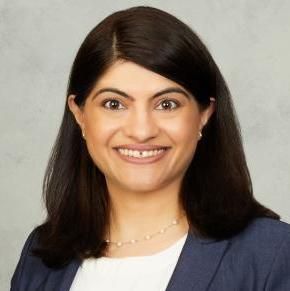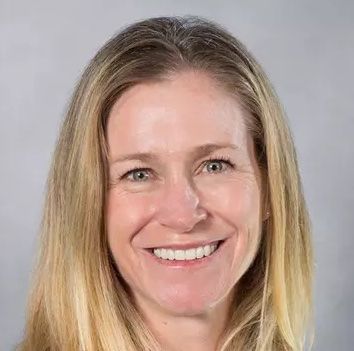Recap: Recent Advances in Multiple Myeloma From IMS 2022 and Beyond
A panel of experts in multiple myeloma discusses recent data updates from 2022 International Myeloma Society Annual Meeting and how it influences treatment strategies in clinical practice.
Surbhi Sidana, MD
Stanford University School of Medicine
Stanford, CA

Larry Anderson, MD, PhD
The University of Texas Southwestern Medical Center
Dallas, TX

Caitlin Costello, MD
University of California San Diego
San Diego, CA

Andrew J. Cowan, MD
University of Washington/Fred Hutchinson Cancer Research Center
Seattle, WA

Rebecca Silbermann, MD, MMS
Oregon Health and Science University
Portland, OR

At an Around the Practice® program hosted by CancerNetwork®, experts led by Surbhi Sidana, MD, assistant professor in the Department of Medicine, Division of Blood and Marrow Transplantation & Cellular Therapy and the Myeloma Cellular Immunotherapy program lead at Stanford University School of Medicine in California, spoke about treatment options for patients with multiple myeloma following data presented at the 2022 International Myeloma Society Annual Meeting [IMS 2022].
Additional panelists included Larry Anderson, MD, PhD, professor in the Department of Internal Medicine at The University of Texas Southwestern Medical Center in Dallas; Caitlin Costello, MD, associate professor of medicine at the University of California San Diego in California; Andrew J. Cowan, MD, interim clinical director of the Myeloma Service and research associate in the Clinical Research Division at the Fred Hutchinson Cancer Research Center as well as assistant professor in the Division of Medical Oncology at the University of Washington School of Medicine in Seattle; and Rebecca Silbermann, MD, MMS, associate professor of medicine in the Division of Hematology/Medical Oncology at the Oregon Health and Science University School of Medicine in Portland.
The Evolving Treatment Landscape in Transplant-Eligible Multiple Myeloma
Sidana: It’s a very controversial issue whether everyone should undergo a transplant. Can you share data from the phase 2 GRIFFIN study [NCT02874742] that were presented at the IMS 2022 and your takeaways?
Costello: We know that the primary end point of that trial was the stringent complete remission [sCR] rates of these patients [with newly diagnosed transplant-eligible multiple myeloma] after consolidation. These patients underwent induction followed by autologous stem cell transplant followed by consolidation. Originally, we could see when initial data were coming out at the planned interim analysis that there was a significant improvement in sCR with the quadruplet [regimen of daratumumab (Darzalex), lenalidomide (Revlimid), bortezomib (Velcade), and dexamethasone (Dara-VRd)] compared with the triplet regimen [RVd].1 We received the final analysis here at IMS 2022. After the 2-year follow-up, we can see not only a significant improvement in sCR, but also improved MRD [minimal residual disease] negativity rates with durability.2 It’s getting harder and harder to ignore the fact that quadruplet regimens are quite effective for these patients, both to achieve initial deep responses and durability.
Sidana: We also have Dara-KRd, which is a quadruplet regimen of daratumumab, carfilzomib [Kyprolis], lenalidomide, and dexamethasone. We had some data presented at ASH 2021 [2021 American Society for Hematology Annual Meeting & Exposition] from the MASTER trial [NCT03224507] by Luciana J. Costa, MD, PhD, which was an academic consortium trial.3 It looked at MRD negativity as an end point to stop [or continue] therapy. How can we incorporate Dara-KRd into the clinical landscape and should patients be getting that regimen over the other quadruplets we have right now?
Silbermann: That trial was written at a time when we thought Dara-KRd would be a better regimen than Dara-VRd. MASTER taught us that we could mobilize a group of academic institutions to ask the very interesting and important question: do patients who are considered transplant eligible need to continue a maintenance regimen forever? We learned that Dara-KRd is a tolerable regimen and that toxicity was as expected and was not necessarily worse than the toxicity that we saw for Dara-VRd. We began to learn how important it is to follow an MRD end point for these individuals.
Sidana: Based on the MRD-SURE data where treatment was discontinued if patients achieved MRD twice, we [still] saw that some patients were relapsing.3 Can you talk about the subgroup of patients that was more likely to relapse and what to make of that?
Silbermann: The MASTER design was adjusted during the trial and there was an enrichment to include patients with several high-risk cytogenetic abnormalities. In some of the updates that have been provided at conferences, we’ve seen that there is a difference in how patients do when they have higher-risk vs standard-risk disease. There was a small number of patients who had relapsed from the MRD-SURE cohorts, but those were generally patients who had very high-risk diseases. This confirmed a lot of the information that we had so far about myeloma risk stratification at the initiation of therapy.
Sidana: Can you discuss the results and the design of the phase 3 DETERMINATION study [NCT01208662]?4
Anderson: DETERMINATION was a randomized phase 3 trial in patients with newly diagnosed transplant-eligible myeloma who were randomized to either VRd with or without an upfront stem cell transplant. These patients had several cycles of VRd with or without a transplant and then received lenalidomide maintenance. The biggest news from this that was presented at 2022 ASCO [2022 American Society of Clinical Oncology Annual Meeting] and also published in the New England Journal of Medicine was regarding the difference in the median progression-free survival [PFS], which was over 21 months better in the transplant group vs the nontransplant or delayed transplant group at 67.5 months vs 46.2 months, respectively [HR, 1.53; 95% CI, 1.23-1.91; P <.001].4 This also held up in the high-risk chromosome subgroups, with PFS at 55.5 month compared with 17.1 without the transplant [HR, 1.66; 95% CI, 1.21-2.27]. Those results are pretty practice changing.
Sidana: How do you take those results and integrate them in your practice?
Anderson: We don’t know the criteria for who would benefit the most from transplant vs not. We do have a subgroup analysis that looked at patients who achieved MRD-negative status before their maintenance therapy. Those who achieved MRD negativity did equally well whether they had a transplant or not. The other key takeaway is that in this study, patients stayed on their maintenance indefinitely until progression vs in the IFM-2009 study where they stopped after a year and saw inferior overall results when they didn’t continue maintenance.5
I do that in anyone who is willing and able, but not everyone is always able to tolerate it until progression. If there are patients who are MRD-negative, when can you stop? That’s a whole debate as well.
Translating Evidence to Improve Outcomes in Transplant-Ineligible Multiple Myeloma
Sidana: Disease biology and patient fitness are both very important in the treatment of transplant-ineligible multiple myeloma. At the first appointment, we need to take an in-depth look at the patient so we can decide the best treatment for them. We keep getting updates from the phase 3 MAIA trial [NCT02252172], can you give us a summary of how the responses looked with daratumumab in addition to lenalidomide and dexamethasone (DRd)?
Anderson: MAIA was a randomized study comparing triplet DRd vs Rd [lenalidomide and dexamethasone]. The impressive thing was that not only did we see extended PFS but also an enhanced overall survival advantage for these patients treated with the added CD38 monoclonal antibody. At 5 years, 66.3% were still alive with the triplet therapy compared with 53.1% with the doublet.6
Sidana: We saw recent publication in Leukemia looking at frail patients who were on the MAIA study and we saw similar benefit in terms of PFS and response rate.7 Do you ever consider not giving a frail patient a triplet regimen? How do you interpret the results of those studies knowing that they were on clinical trials?
Anderson: The results held up in the frail patients with improved PFS, but it goes back to how fit these patients are. [Their ability] to come in for weekly injections is one of the biggest criteria for this regimen because if they don’t have a support system or transportation or if they can hardly get out of bed, they’re not going to be able to receive this therapy. For those patients who are at the other extreme of the frailty index and very unfit, you could potentially consider a doublet or even an oral triplet where they’re only coming in monthly.
Sidana: [In this setting], we have DRd based on MAIA, VRd based on SWOG 2077 [NCT00644228], and we have KRd as well. In high-risk patients, the teaching has been that we always need a proteasome inhibitor based on the data from the HOVON-65/GMMG-HD4 trial.8 Patients who got bortezomib-based induction and maintenance, especially if they were high risk with deletion 17p or translocation, had outcomes that were just as good as standard risk patients. That’s really perpetuated this teaching that everybody who has high-risk disease must get a proteasome inhibitor.
If a 75-year-old patient comes to you with high-risk disease or even double hit disease, with deletion 17p and 1q gain, how do you select induction therapy?
Costello: It’s important to understand their performance status because age is just a number. It’s important to review their medical history to understand what toxicities they could potentially manage, whether it’s underlying hypertension or peripheral neuropathy relative to diabetes. Realistically, the expected survival of patients in their 70s is quite long with or without myeloma so we would like to prolong and maintain that as best as we can without adding additional toxicity.
I want to look at their performance status and their comorbidities, but also the biology of the disease. If you have a 75-year-old with double hit disease, I want a quadruplet for them especially if they are fit and they have a good performance status. For someone who does not necessarily meet that criteria, what’s nice about the MAIA data is it incorporated all comers—older patients, those with high-risk or standard-risk disease—and they had just remarkable outcomes. You must look at the patient as a whole and you can’t just pick out the high-risk disease and treat that. You must understand the patient and approach it as personalized as you can.
Expanding the Treatment Armamentarium
Sidana: We’ve talked a lot about using daratumumab up front in quadruplet and triplet regimens. Do you think it’s a drug that’s better-used upfront or in relapse?
Silbermann: I was previously uncertain about whether we should be using it upfront or not, but I believe that the initial induction response is perhaps the most important one and it’s really encouraging that we see these durable response rates, so I am not saving it anymore. If we can get someone to a deep response, they’ll be better off overall.
Sidana: A study presented at ASH showed a lot of patients never get a second- and third-line treatment regimen so [you should] use your most potent regimens in frontline.9 Do you ever reuse anti-CD38 antibodies, be it daratumumab or isatuximab [Scarlisa]?
Cowan: You have to look at a few things, one being their response? Did they progress on a CD38 antibody, or did they get a CASSIOPEIA-style or GRIFFIN-style [regimen] where they got it for a total of 2.5 years and then discontinued? A patient who got daratumumab in the past and stopped later [before progression] is different from one who progresses on a CD38 antibody. If a patient is progressing on a CD38 antibody, I’m not going to give another CD38 antibody. Now, if someone responded and progressed, I might think twice about reusing it. The reality is when you get [to the third and fourth] lines, we’re not trying to get MRD negativity. Stable disease is the goal for many of these patients because it means you can go on to the next study or go long enough until the next drug gets approved. Those are the factors I would generally consider.
References
- Voorhees PM, Kaufman JL, Laubach J, et al. Daratumumab, lenalidomide, bortezomib, and dexamethasone for transplant-eligible newly diagnosed multiple myeloma: the GRIFFIN trial. Blood. 2020;136(8):936-945. doi: 10.1182/blood.2020005288
- Sborov DW, Laubach J, Kaufman JL, et al. Daratumumab (dara) + lenalidomide, bortezomib, and dexamethasone (RVd) in patients with transplant-eligible newly diagnosed multiple myeloma (NDMM): final analysis of GRIFFIN. Presented at: 19th International Myeloma Society Annual Meeting; August 25-27, 2022; Los Angeles, CA. Abstract OAB-057
- Costa LJ, Chhabra S, Callander NS, et al. Daratumumab, carfilzomib, lenalidomide and dexamethasone (Dara-KRd), autologous transplantation and MRD response-adapted consolidation and treatment cessation. final primary endpoint analysis of the MASTER trial. Blood. 2021;138(suppl 1):481. doi:10.1182/blood-2021-145494
- Richardson PG, Jacobus SJ, Weller EA, et al. Triplet therapy, transplantation, and maintenance until progression in myeloma. N Engl J Med. 2022;387(2):132-147. doi:10.1056/NEJMoa2204925
- Attal M, Lauwers-Cances V, Hulin C, et al. Lenalidomide, bortezomib, and dexamethasone with transplantation for myeloma. N Engl J Med. 2017;376(14):1311-1320. doi:10.1056/NEJMoa1611750
- Facon T, Kumar SK, Plesner T, et al. Daratumumab, lenalidomide, and dexamethasone versus lenalidomide and dexamethasone alone in newly diagnosed multiple myeloma (MAIA): overall survival results from a randomised, open-label, phase 3 trial. Lancet Oncol. 2021;22(11):1582-1596. doi:10.1016/S1470-2045(21)00466-6
- Facon T, Cook G, Usmani SZ, et al. Daratumumab plus lenalidomide and dexamethasone in transplant-ineligible newly diagnosed multiple myeloma: frailty subgroup analysis of MAIA. Leukemia. 2022;36(4):1066-1077. doi:10.1038/s41375-021-01488-8
- Sonneveld P, Schmidt-Wolf IG, van der Holt B, et al. Bortezomib induction and maintenance treatment in patients with newly diagnosed multiple myeloma: results of the randomized phase III HOVON-65/ GMMG-HD4 trial. J Clin Oncol. 2012;30(24):2946-2955. doi:10.1200/JCO.2011.39.6820
- Fonesca R, Facon T, Hashim M, et al. First-line use of daratumumab, lenalidomide, and dexamethasone confers survival benefit compared with second-line use of daratumumab-based regimens in transplant-ineligible patients with multiple myeloma: analysis of different clinical scenarios. Blood. 2021;138(suppl 1):118. doi: 10.1182/blood-2021-144914
EP: 1.Choosing the Appropriate Induction Regimen in Transplant-Eligible NDMM
EP: 2.Minimal Residual Disease-Response Adapted Therapy in Transplant-Eligible NDMM
EP: 3.Determining the Right Patients with NDMM for Autologous Stem Cell Transplant
EP: 4.Duration of Therapy and Maintenance Treatment in Transplant-Eligible NDMM
EP: 5.Treating Patients with High-Risk NDMM
EP: 6.Factors to Consider for Frontline Treatment of Transplant-Ineligible MM
EP: 7.Transplant-Ineligible Multiple Myeloma: The MAIA and SWOG 0777 Trials
EP: 8.Transplant-Ineligible Multiple Myeloma: The ENDURANCE Study
EP: 9.Role of Triplet Therapy in Frail Patients with Transplant-Ineligible NDMM
EP: 10.Maintenance Therapy in Transplant-Ineligible NDMM
EP: 11.Available Treatment Options for Relapsed/Refractory Multiple Myeloma
EP: 12.Bispecific Antibodies in the Treatment of R/R MM
EP: 13.CAR-T Therapy in R/R MM Treatment
EP: 14.Choosing a Bispecific Antibody for Treatment of R/R MM After Prior BCMA Therapy
EP: 15.Sequencing Therapies in Patients with R/R MM
EP: 16.Reflecting on Unmet Needs in Multiple Myeloma After IMS 2022
EP: 17.Recap: Recent Advances in Multiple Myeloma From IMS 2022 and Beyond
Navigating AE Management for Cellular Therapy Across Hematologic Cancers
A panel of clinical pharmacists discussed strategies for mitigating toxicities across different multiple myeloma, lymphoma, and leukemia populations.